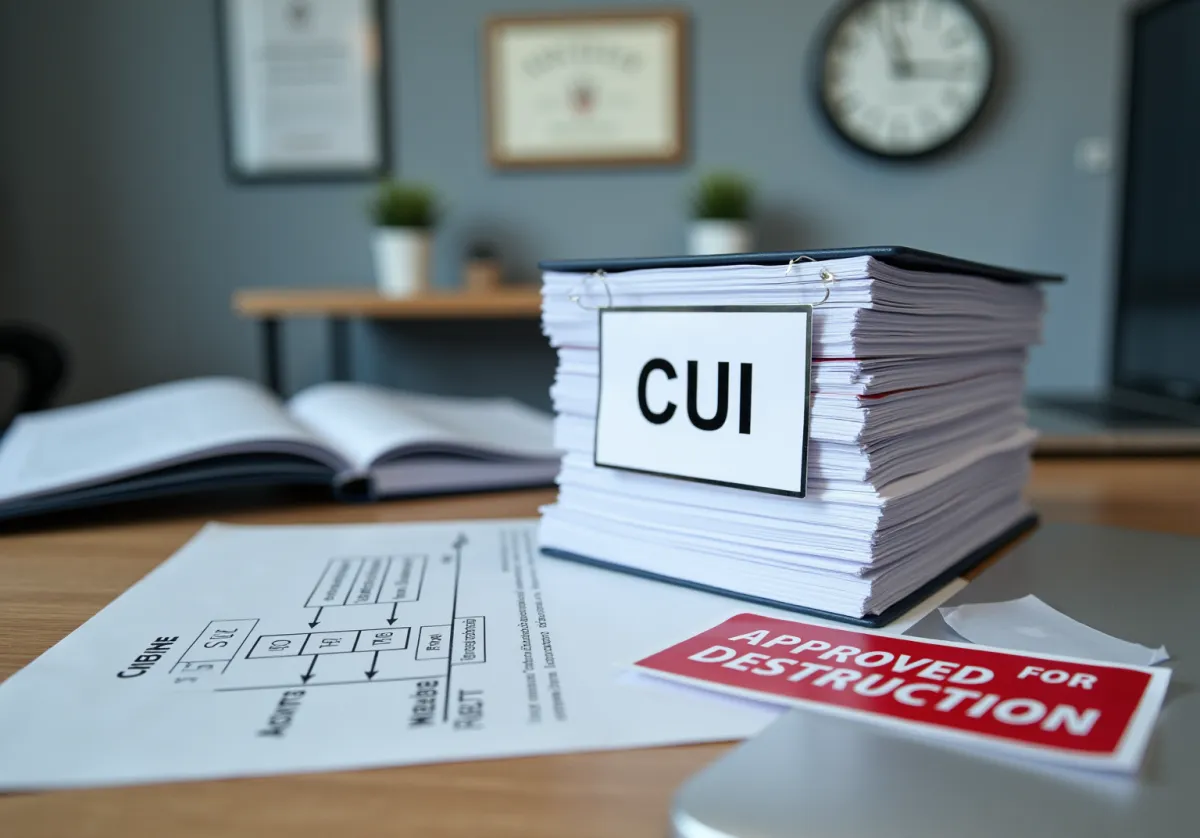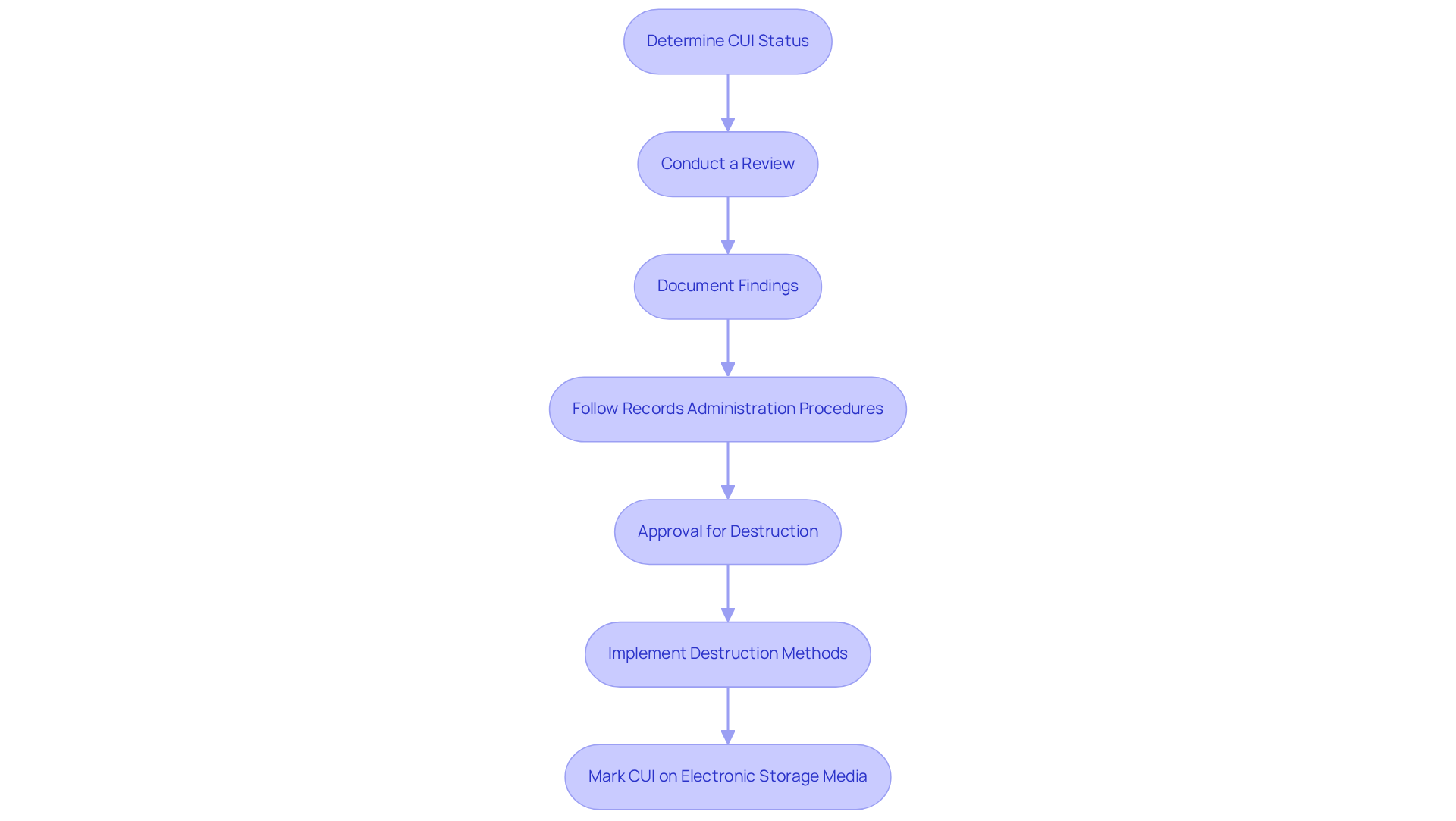CUI Documents: Review Procedures Before Destruction Explained
CUI documents must be reviewed according to which before destruction to ensure compliance and security.

Overview
CUI documents must undergo a comprehensive review process before destruction. Why is this crucial? It ensures compliance with regulations and helps determine whether the information should be retained or can be destroyed.
The review process involves several critical steps:
- Verifying CUI status: Confirm the classification of the information.
- Conducting a review with a designated records manager: Collaborate with an expert to assess the documents.
- Documenting findings: Keep a detailed record of the review process.
- Obtaining necessary approvals: Secure the required permissions before proceeding with destruction.
These steps collectively safeguard sensitive information and mitigate legal risks. By adhering to this process, organizations not only comply with regulations but also protect their interests. Are you ready to implement these practices in your organization?
Introduction
Understanding the complexities of Controlled Unclassified Information (CUI) is essential for organizations that handle sensitive data. This article explores the critical review procedures that must be followed before the destruction of CUI documents, emphasizing the legal implications and compliance requirements involved. As the stakes rise for mishandling such information, organizations must ask: what specific steps can they take to ensure compliance while safeguarding their reputation and operational integrity?
To begin with, organizations need to establish a robust framework for reviewing CUI documents prior to their destruction. This involves not only understanding the legal requirements but also implementing best practices that align with compliance standards. For instance, organizations should conduct thorough audits of their CUI handling processes, ensuring that all personnel are trained in the appropriate protocols.
Moreover, the consequences of failing to comply with CUI regulations can be severe, including legal penalties and reputational damage. Therefore, it is imperative for organizations to prioritize these review procedures. By doing so, they not only protect themselves legally but also reinforce their commitment to data security and integrity.
In conclusion, organizations must take proactive steps to navigate the complexities of CUI. By implementing comprehensive review procedures and fostering a culture of compliance, they can effectively mitigate risks and enhance their operational resilience.
Understand Controlled Unclassified Information (CUI)
Controlled Unclassified Information (CUI) is more than just unclassified data; it’s information that requires safeguarding or dissemination controls as mandated by law, regulation, or government policy. This category includes sensitive data like personally identifiable information (PII), proprietary business content, and other materials that, while not classified, still need protection. Understanding the nuances of CUI is essential for compliance with Department of Defense (DoD) regulations. Mishandling or improperly destroying CUI documents must be reviewed according to which before destruction can lead to serious legal and operational consequences.
Organizations must familiarize themselves with the various CUI categories, which encompass critical infrastructure data, export-controlled materials, and sensitive international agreements. Each category comes with specific handling requirements that must be adhered to in order to comply with regulations. For example, the DoD requires contractors to implement protective measures for covered defense information, as outlined in DFARS 252.204-7012. This regulation underscores the importance of safeguarding sensitive data and mandates reporting any cyber incidents.
The CMMC Info Hub serves as a comprehensive resource for achieving and maintaining Cybersecurity Maturity Model Certification (CMMC) compliance. It offers practical strategies and peer experiences that simplify the complexities of meeting requirements. Within this hub, the CUI Registry is an invaluable tool for identifying CUI categories and their associated requirements, aiding contractors in navigating compliance effectively.
Consider the real-world implications of mishandling CUI. Defense contractors that fail to manage CUI properly risk not only legal penalties but also damage to their reputation and future eligibility for government contracts. Cybersecurity specialists emphasize the necessity of establishing robust data security practices. As Tony Giles points out, "Small to midsized businesses can begin with the basics. Security awareness training, password controls, and high-level leadership commitment are good first steps."
In conclusion, recognizing the importance of safeguarding CUI and adhering to current regulations is crucial for organizations within the defense industrial base. By understanding CUI categories and their related requirements, contractors can ensure that CUI documents must be reviewed according to which before destruction, thus enhancing their compliance posture and protecting sensitive data. The CMMC Info Hub is here to support you in this vital endeavor.

Identify Review Procedures for CUI Document Destruction
Before any Controlled Unclassified Information (CUI), CUI documents must be reviewed according to which before destruction, it must undergo a comprehensive review process. This process includes several critical steps:
-
Determine CUI Status: First, verify that the document is classified as CUI by checking its markings and associated metadata. This initial step is crucial for ensuring compliance.
-
Conduct a Review: Next, engage a designated records manager or compliance officer to assess the document. This review should establish whether the document contains information that must be retained or if CUI documents must be reviewed according to which before destruction.
-
Document Findings: It’s essential to record the results of the review. Note any information that must be retained and the rationale for destruction. This documentation is vital for compliance audits and must include a sanitization log to track all actions taken.
-
Follow Records Administration Procedures: Ensure that the review process aligns with your organization’s records policies. Adhere to federal regulations and DoD guidelines, including those outlined in DoDI 5200.48.
-
Approval for Destruction: Before proceeding with destruction, obtain the necessary approvals from relevant authorities. This may involve multiple stakeholders, depending on your organization’s structure and the sensitivity of the data involved. Documenting all approvals is crucial.
-
Implement Destruction Methods: Once destruction is approved, utilize methods that comply with NIST SP 800-88 standards. Options include shredding, incineration, or pulverization, ensuring that the CUI is rendered unreadable, indecipherable, and irrecoverable.
-
Mark CUI on Electronic Storage Media: Finally, ensure that any electronic storage media containing CUI is properly marked. This is a critical aspect of CUI oversight.
Implementing these best practices not only ensures compliance with CUI regulations but also enhances your organization’s overall information security posture. Are you ready to take the necessary steps to protect your sensitive information?

Implement Effective Records Management Practices
To implement effective records management practices for Controlled Unclassified Information (CUI), organizations must take decisive steps:
-
Establish a Records Management Policy: Begin by developing a comprehensive policy that clearly outlines how CUI will be managed. This includes detailed procedures for the creation, storage, access, and destruction of records, and CUI documents must be reviewed according to which before destruction. A well-defined policy sets the foundation for compliance and accountability.
-
Train Staff: Regular training sessions are essential. Ensure that employees are well-versed in CUI handling and record-keeping practices. It’s crucial that all staff understand the importance of adhering to regulations and the specific procedures they must follow. How confident are you that your team is prepared?
-
Utilize Technology: Leverage advanced records handling software to track CUI documents throughout their lifecycle. This technology not only automates regulatory checks but also streamlines the review process, making compliance more manageable and efficient.
-
Conduct Regular Audits: Establish a timeline for routine evaluations of your CUI records management practices. Regular audits guarantee adherence to established policies and help identify areas for improvement. Are you regularly assessing your compliance measures?
-
Maintain documentation by keeping meticulous records of all CUI documents, as CUI documents must be reviewed according to which before destruction, including their status, review findings, and destruction approvals. This documentation is vital for demonstrating compliance during audits and inspections. Are your records as thorough as they should be?
By following these steps, organizations can ensure robust records management practices for CUI, fostering a culture of compliance and accountability.

Conclusion
Understanding and managing Controlled Unclassified Information (CUI) is critical for organizations, particularly those in the defense sector. Safeguarding CUI requires not only recognizing its sensitive nature but also adhering to specific review procedures before any destruction can occur. This process ensures compliance with legal and regulatory frameworks, ultimately protecting both the organization and its stakeholders.
Key steps in the review process for CUI document destruction include:
- Verifying CUI status
- Conducting thorough assessments
- Documenting findings
- Ensuring adherence to established records management policies.
Each step is essential to maintain compliance and mitigate risks associated with mishandling sensitive information. By implementing effective records management practices, organizations can foster a culture of accountability and security, thereby enhancing their overall data protection strategies.
Given the rising importance of CUI in government and defense operations, organizations must prioritize understanding and following these guidelines. Taking proactive measures to implement robust records management systems not only safeguards sensitive information but also positions organizations for success in meeting compliance standards. It is imperative for all stakeholders to recognize the significance of these practices and commit to ongoing training and audits to ensure that CUI is handled with the utmost care and diligence.
Frequently Asked Questions
What is Controlled Unclassified Information (CUI)?
Controlled Unclassified Information (CUI) is information that requires safeguarding or dissemination controls as mandated by law, regulation, or government policy. It includes sensitive data such as personally identifiable information (PII) and proprietary business content that, while unclassified, still needs protection.
Why is understanding CUI important for organizations?
Understanding CUI is essential for compliance with Department of Defense (DoD) regulations. Mishandling or improperly destroying CUI documents can lead to serious legal and operational consequences.
What categories are included under CUI?
CUI categories include critical infrastructure data, export-controlled materials, and sensitive international agreements. Each category has specific handling requirements that organizations must adhere to.
What regulation outlines the protective measures for covered defense information?
The DoD requires contractors to implement protective measures for covered defense information as outlined in DFARS 252.204-7012, which emphasizes the importance of safeguarding sensitive data and mandates reporting any cyber incidents.
What resources are available for achieving Cybersecurity Maturity Model Certification (CMMC) compliance?
The CMMC Info Hub serves as a comprehensive resource for achieving and maintaining CMMC compliance, offering practical strategies and peer experiences to simplify meeting requirements. The CUI Registry within the hub helps identify CUI categories and their associated requirements.
What are the consequences of mishandling CUI for defense contractors?
Defense contractors that fail to manage CUI properly risk legal penalties, damage to their reputation, and future eligibility for government contracts.
What basic security practices are recommended for small to midsized businesses?
Recommended basic security practices include security awareness training, password controls, and high-level leadership commitment to establish robust data security practices.
How can organizations enhance their compliance posture regarding CUI?
Organizations can enhance their compliance posture by understanding CUI categories and their related requirements, ensuring that CUI documents are reviewed according to regulations before destruction, and utilizing resources like the CMMC Info Hub for support.




